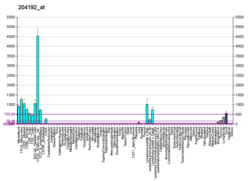Top Qs
Timeline
Chat
Perspective
CD37
Mammalian protein found in humans From Wikipedia, the free encyclopedia
Remove ads
Leukocyte antigen CD37 is a protein that in humans is encoded by the CD37 gene.[5][6]
Remove ads
Function
The protein encoded by this gene is a member of the transmembrane 4 superfamily, also known as the tetraspanin family. Most of these members are cell-surface proteins that are characterized by the presence of four hydrophobic transmembrane domains. Tetraspanins mediate signal transduction events that play a role in the regulation of immune responses, cell development, activation, growth and motility.[7][8][9][10] CD37 expression is restricted to cells of the immune system, with highest abundance on mature B cells, and lower expression is found on T cells and myeloid cells. CD37 is a cell surface glycoprotein that is known to complex with integrins and other transmembrane 4 superfamily proteins. Alternate splicing results in multiple transcript variants encoding different isoforms.[6] CD37 controls both humoral[11][12] and cellular immune responses.[13][14][15] CD37-deficiency in mice leads to spontaneous development on B cell lymphoma,[16] and patients with CD37-negative lymphomas have a worse clinical outcome.[17]
Remove ads
See also
References
Further reading
External links
Wikiwand - on
Seamless Wikipedia browsing. On steroids.
Remove ads





